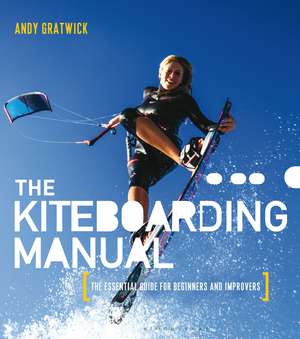The Kiteboarding Manual: The essential guide for beginners and improvers
Autor Andy Gratwicken Limba Engleză Paperback – 22 apr 2015
Preț: 121.85 lei
Preț vechi: 208.97 lei
-42% Nou
Puncte Express: 183
Preț estimativ în valută:
23.33€ • 24.29$ • 19.36£
23.33€ • 24.29$ • 19.36£
Cartea nu se mai tipărește
Doresc să fiu notificat când acest titlu va fi disponibil:
Se trimite...
Preluare comenzi: 021 569.72.76
Specificații
ISBN-13: 9781408192030
ISBN-10: 1408192039
Pagini: 208
Ilustrații: Colour photos and illustrations throughout
Dimensiuni: 208 x 235 x 10 mm
Greutate: 0.59 kg
Editura: Bloomsbury Publishing
Colecția Adlard Coles
Locul publicării:London, United Kingdom
ISBN-10: 1408192039
Pagini: 208
Ilustrații: Colour photos and illustrations throughout
Dimensiuni: 208 x 235 x 10 mm
Greutate: 0.59 kg
Editura: Bloomsbury Publishing
Colecția Adlard Coles
Locul publicării:London, United Kingdom
Caracteristici
The author is the ISAF technical expert and director of the ISAF kiteboard training scheme internationally, and is also the head of the BKSA training scheme
Notă biografică
Andy Gratwick is Head of Training at the British Kitesports Association and the first ISAF technical expert for kiteboarding in the world. He graduated with a degree in marine navigation and maritime law, and has been in watersports his entire career. He's also a RYA Yachtmaster; trainer and examiner for kitesurfing, snow and land kiting; and BSUPA Head Coach for SUP in the UK.
Cuprins
PART 1 - NEED TO KNOW Chapter 1: The sport: A brief history The early years Kites on snow The sport moves to water Kiteboarding goes mainstream Where it is now Looking forwards Chapter 2: Air How a kite flies Drag Lift Angle of attack Steering Where a kite flies (the wind window) The 'static' wind window The 'dynamic' wind window Where wind comes from Low-pressure systems High-pressure systems Clouds Storms, hurricanes and cyclones Sea and land breezes Trade winds Atlantic Ocean Pacific Ocean Indian Ocean Airflow and local wind phenomena Laminar flow Turbulent flow Chapter 3: Water Tides and currents Formulation Spring and neap tides Rips and currents Effects of tides on kiteboarders Water states: making waves The seas, oceans, rivers and lakes Time on the water Part 2 - THE JOURNEY: BECOMING A KITEBOARDER Chapter 4: Getting started Start with yourself - health, safety and attitude Common questions Chapter 5: The kite Basic powerkite-flying on land LEI Rigging and assembly Pre-flight checks Launching an LEI kite Landing an LEI kite Body-dragging Power: downwind figure-of-eight body-dragging Direction: crosswind body-dragging Retrieving the board: body-dragging with/back to the board Balance (stability and control): the balance-drag Relaunching a kite Hybrid 4-line kites 5-line kites: 5th-line relaunch Chapter 6: The board How the board works Getting the board on Standing up The first runs Stopping and basic turning Stopping Turning (the sitting gybe) Avoiding accidents Rules of the Road Common-sense rules Structured rules Communications and signals Launching Abort launch/do not launch Landing Eject/release the safety Help/distress Go right /go left Kite to 12 o'clock Come to me Chapter 7: Safety, breakages and self-rescues Site and risk assessment Equipment failure Safety pack-down Sailing in Deep-water pack-up Packing up in emergencies Maintenance and repairs Repairing a kite tube Repairing a canopy tear Repairing a board Chapter 8: Advanced techniques Self-launching and landing Self-launching a hybrid and C-kite Self-launching a bow kite Self-landing Dual launching and landing The beach-start Setting it up The go Coming in with style Setting it up The go Kiting with boat support Chapter 9: Points of sailing Beam reach Broad reach Dead run Close-hauled/close reach Apparent wind Chapter 10: Going upwind The kite The board The rider Riding toeside Turning and transitions Heel-to-toeside carve Toe-to-heelside carve Jump transition The BLT Handplant BLT Front loop transition Backloop-kiteloop transition Chapter 11: Going fast, high and loose The chop hop Sending the kite The take-off Airtime The landing Looping yourself Looping the kite Gybing Tacking The bottom turn and waveriding Chapter 12: Equipment Manufacturing Knowing what's right for you Types of kite Frame kites Foil kites LEI/tube kites Aspect ratio C-kites Bow kites Hybrid kites Boards Twin-tips Directionals Bars Lines Chicken loop Trimline Safety leash 4- and 5-line bars Software Wetsuits Rash vests Harnesses Helmets Buoyancy aids and impact jackets Buying your own equipment Transporting kit Part 3: THE FUTURE Chapter 13: Kiteboarding disciplines Kiting on land Kite buggying Mountain boarding Snowkiting Speed kiting on land Freestyle Wakestyle Waveriding Racing Border cross Long-distance racing Hydrofoiling Speed kiting Chapter 14: Competitions Tour circuits PKRA KSP KTE KTA The Triple-S Invitational The IKA World Tour Freestyle competitions Waveriding competitions Chapter 15: Governance ISAF IKA BKSA IKO National structures Chapter 16: Taking it to a new level Becoming an instructor Improving your performance, advanced coaching and competing The industry The future is bright
